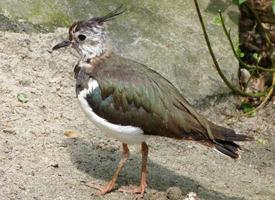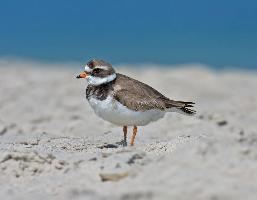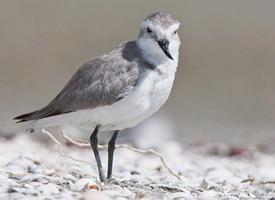
Statut de conservation
| Menacé |
Description de l'animal
The Sociable Lapwing, scientifically known as Vanellus gregarius, is a fascinating and critically endangered species of bird that belongs to the lapwing family. This intriguing species is characterized by its unique appearance, migratory behavior, and increasingly rare sightings, making it a subject of concern and interest among conservationists and bird enthusiasts worldwide.Physical Description:
The Sociable Lapwing is a medium-sized bird, measuring approximately 29 to 32 centimeters in length, with a wingspan that can reach up to 70 centimeters. It exhibits a distinctive plumage that is a blend of subtle and striking features. During the breeding season, adults display a striking black crown and a white forehead, which contrast sharply with their greyish-brown back and wings. Their underparts are white, and a unique black band runs across their breast, setting them apart from other lapwing species. The tail is white with a black terminal band. One of the most striking features of the Sociable Lapwing is its long, pinkish legs, which are conspicuous against its body coloration. Both males and females look similar, although males tend to have slightly brighter plumage during the breeding season.
Behavior and Ecology:
Sociable Lapwings are known for their nomadic lifestyle, especially outside the breeding season. They are highly migratory, undertaking long-distance flights from their breeding grounds in the steppes of Kazakhstan and parts of Russia to their wintering areas in Africa, the Middle East, and the Indian subcontinent. This migratory behavior exposes them to a variety of habitats, from arid deserts to fertile agricultural lands.
During the breeding season, Sociable Lapwings prefer open landscapes with short vegetation, where they lay their eggs in shallow ground nests. This species is unique in its social behavior; unlike many other lapwings that are territorial during the breeding season, Sociable Lapwings are known to breed in loose colonies, a trait that possibly inspired their common name.
The diet of the Sociable Lapwing primarily consists of insects and other small invertebrates, which they forage from the ground. Their long legs are adapted for walking through grasslands and fields in search of food.
Conservation Status:
The Sociable Lapwing is classified as Critically Endangered by the International Union for Conservation of Nature (IUCN). The species has experienced a dramatic decline in population over the past few decades, with current estimates suggesting a global population of only a few thousand individuals. The primary threats to their survival include habitat destruction and degradation, particularly due to agricultural expansion and intensification, as well as hunting and disturbance along their migratory routes.
Conservation efforts are underway to protect the Sociable Lapwing and its habitat. These include international cooperation to monitor populations, protect critical habitat areas, and raise awareness about the species' plight. The future of the Sociable Lapwing hinges on the success of these conservation measures and the continued commitment of the global community to safeguard this unique and beautiful bird for future generations.
Animaux similaires
Nouvelles photos d'animaux
Top 10 des animaux
- Dolphin gull (Leucophaeus scoresbii)
- Japanese macaque (Macaca fuscata)
- Stone loach (Barbatula barbatula)
- Greek tortoise (Testudo graeca)
- Russian tortoise (Testudo horsfieldii)
- Galápagos tortoise (Geochelone nigra complex)
- Diana monkey (Cercopithecus diana)
- Moustached guenon (Cercopithecus cephus)
- Common flying dragon (Draco volans)
- Galápagos penguin (Spheniscus mendiculus)


